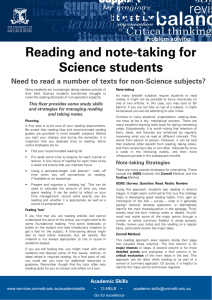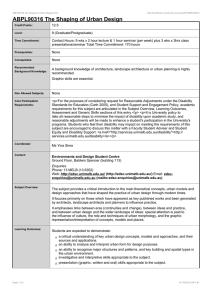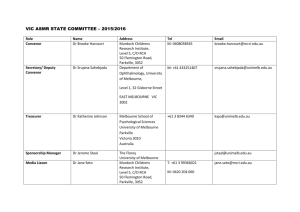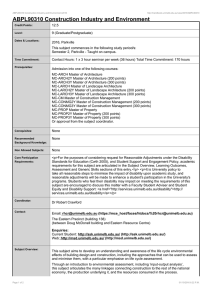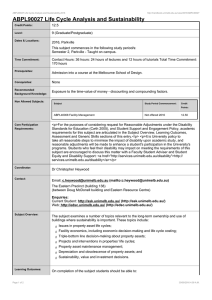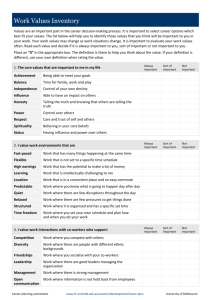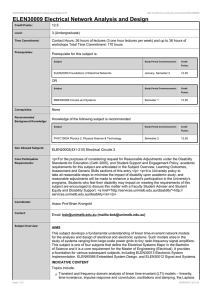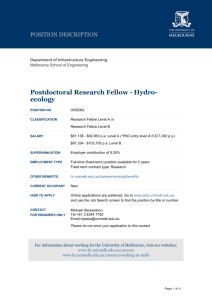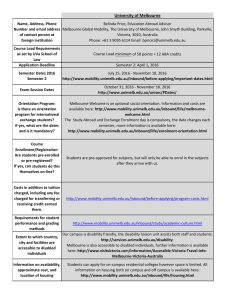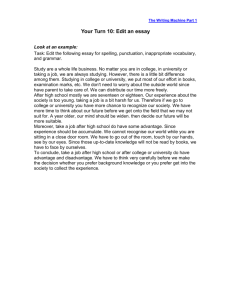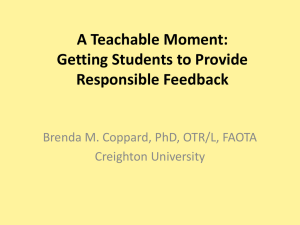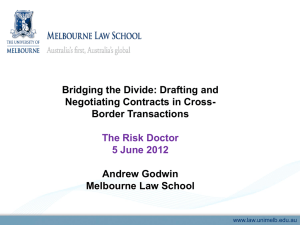Using a writing process
advertisement
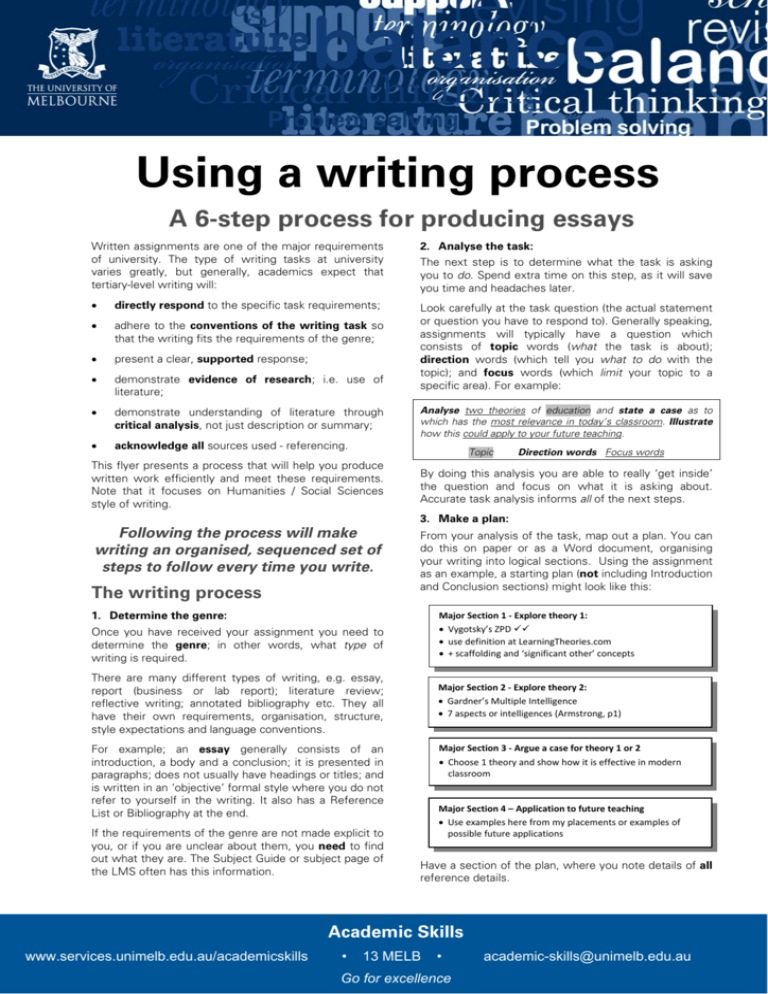
Using a writing process A 6-step process for producing essays Written assignments are one of the major requirements of university. The type of writing tasks at university varies greatly, but generally, academics expect that tertiary-level writing will: directly respond to the specific task requirements; adhere to the conventions of the writing task so that the writing fits the requirements of the genre; present a clear, supported response; demonstrate evidence of research; i.e. use of literature; demonstrate understanding of literature through critical analysis, not just description or summary; acknowledge all sources used - referencing. 2. Analyse the task: The next step is to determine what the task is asking you to do. Spend extra time on this step, as it will save you time and headaches later. Look carefully at the task question (the actual statement or question you have to respond to). Generally speaking, assignments will typically have a question which consists of topic words (what the task is about); direction words (which tell you what to do with the topic); and focus words (which limit your topic to a specific area). For example: Analyse two theories of education and state a case as to which has the most relevance in today’s classroom. Illustrate how this could apply to your future teaching. Topic This flyer presents a process that will help you produce written work efficiently and meet these requirements. Note that it focuses on Humanities / Social Sciences style of writing. Direction words Focus words By doing this analysis you are able to really ‘get inside’ the question and focus on what it is asking about. Accurate task analysis informs all of the next steps. 3. Make a plan: Following the process will make writing an organised, sequenced set of steps to follow every time you write. The writing process From your analysis of the task, map out a plan. You can do this on paper or as a Word document, organising your writing into logical sections. Using the assignment as an example, a starting plan (not including Introduction and Conclusion sections) might look like this: 1. Determine the genre: Major Section 1 ‐ Explore theory 1: Vygotsky’s ZPD use definition at LearningTheories.com + scaffolding and ‘significant other’ concepts Once you have received your assignment you need to determine the genre; in other words, what type of writing is required. There are many different types of writing, e.g. essay, report (business or lab report); literature review; reflective writing; annotated bibliography etc. They all have their own requirements, organisation, structure, style expectations and language conventions. Major Section 2 ‐ Explore theory 2: Gardner’s Multiple Intelligence 7 aspects or intelligences (Armstrong, p1) Major Section 3 ‐ Argue a case for theory 1 or 2 Choose 1 theory and show how it is effective in modern classroom For example; an essay generally consists of an introduction, a body and a conclusion; it is presented in paragraphs; does not usually have headings or titles; and is written in an ‘objective’ formal style where you do not refer to yourself in the writing. It also has a Reference List or Bibliography at the end. If the requirements of the genre are not made explicit to you, or if you are unclear about them, you need to find out what they are. The Subject Guide or subject page of the LMS often has this information. www.services.unimelb.edu.au/academicskills Major Section 4 – Application to future teaching Use examples here from my placements or examples of possible future applications Have a section of the plan, where you note details of all reference details. Academic Skills • 13 MELB • Go for excellence academic-skills@unimelb.edu.au 4. Research and write into your plan: Steps in writing: This is where you find information to use in your writing. You are looking for information to fit the sections of your plan. 1) Free write (1st draft): just write; don’t worry about the word count at this point; get ideas flowing on to the page. The UniMelb website www.library.unimelb.edu.au has two excellent resources you can use for research: Discovery and LibGuides. Take a break – get away from it for a while Discovery, on the Library frontpage, is a facility enabling you to search across databases, catalogues and the digital repository for information sources. LibGuides at www.unimelb.libguides.com provides excellent collections of resource materials specific to discipline, course and subject. Make sure you use these resources. You may find as you research that you refine your initial plan; re-organise, change, delete and re-sequence ideas. As you read, transfer ideas directly into your plan. Fill in the plan with bullet point information, including reference details (author name, page number or URL). Don’t forget this – you can then easily go back and find the information if you need it again. Research-to-plan transfer Major Section 1 ‐ Explore theory 1: Vygotsky … … 2) ‘Hack’ edit (2nd draft): come back and ‘cut’ into the work. At this stage, you might remove sections that are repetitive or irrelevant, shift things around, or make choices about things you don’t need (e.g. if you have compiled six definitions, you may decide to cut back to three). Take a break rd 3) Refine edit (3 draft): come back and ‘fine cut’ the writing. Work on expression and clarity; check grammar and references; make sure the writing answers the question. At this point you need to look at the word count: are you within the +/- 10% range? (There is an expectation that the amount you write will fall within 10% of the word count. E.g. for a 2000 word essay, 1800 – 2200 words is acceptable) Take a break 4) Final edit (last draft): do this 1-2 days prior to submission. Print out the work and ‘hard edit’ it into the word count range. You are editing for: Typos, spelling and grammar mistakes. Formatting, including line spacing, page breaks, font consistency, headings if required In-text referencing and Reference List correctly formatted; sufficient range of sources evident The breaks in between steps are very important. They allow you to create distance from the writing, feel refreshed and be able to have a clear, renewed perspective on the work when you go back to it. Major Section 2 ‐ Explore theory 2: Gardiner … … Support for theory 1 or 2: … … … 6. FINAL STEP - Submit the work: 5. Write: Note that the writing step comes a good way into the process. The benefit of using research-to-plan transfer is that when you are ready to start writing the actual paper, you already have information there! This is a very effective way to prevent writer’s block. Make sure that the writing is ready on the due date. Check the method for submission (print or electronic), where to submit, and exact time and date. Take into account that ‘stuff happens’: printers jam, memory sticks get corrupted etc., so, be prepared. If you can’t submit on time, talk to academic staff and be honest. If submitting hard copy, add a cover page; staple the work in order; and, submit on time! One way to start writing is to try expanding the bullet points you have into sentences and to link related sentences into paragraphs. Further resources Writing is a step-by-step process; it doesn’t just happen at once. Look at the following steps in writing. Gillet, A. Using English for Academic Purposes. Academic Writing. Retrieved 3 Feb 2012 from http://www.uefap.com/writing/writfram.htm Chick, H. Guide to essay standards and report writing. PDF document on UniMelb website. Search by title. Tertiary Essay Writing. A guide produced by Academic Skills available at http://cms.unimelb.edu.au/studentservices/asu/flyers/skill www.services.unimelb.edu.au/academicskills Academic Skills • 13 MELB • Go for excellence V1 1012 SC academic-skills@unimelb.edu.au
